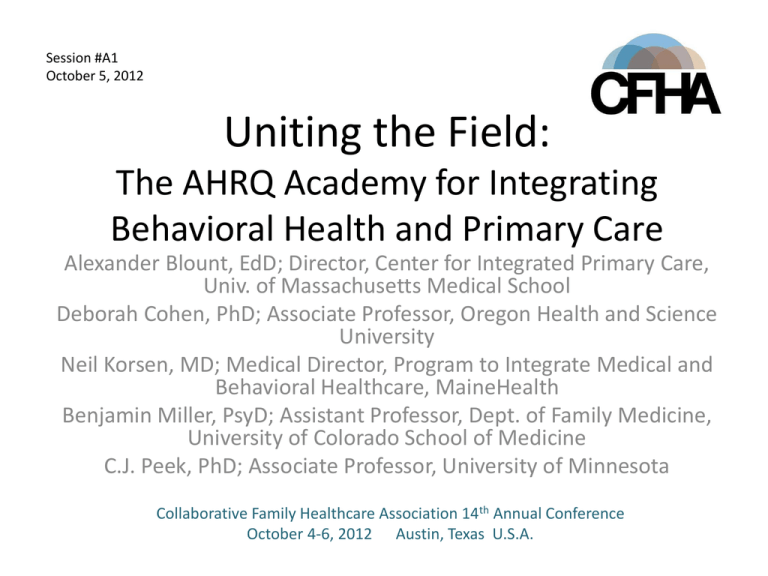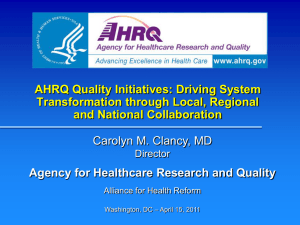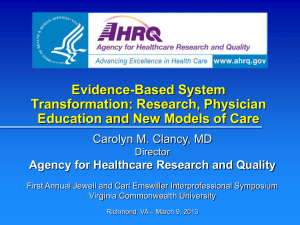Measures - Collaborative Family Healthcare Association
advertisement

Session #A1 October 5, 2012 Uniting the Field: The AHRQ Academy for Integrating Behavioral Health and Primary Care Alexander Blount, EdD; Director, Center for Integrated Primary Care, Univ. of Massachusetts Medical School Deborah Cohen, PhD; Associate Professor, Oregon Health and Science University Neil Korsen, MD; Medical Director, Program to Integrate Medical and Behavioral Healthcare, MaineHealth Benjamin Miller, PsyD; Assistant Professor, Dept. of Family Medicine, University of Colorado School of Medicine C.J. Peek, PhD; Associate Professor, University of Minnesota Collaborative Family Healthcare Association 14th Annual Conference October 4-6, 2012 Austin, Texas U.S.A. Faculty Disclosure I/We have not had any relevant financial relationships during the past 12 months. Objectives • At the conclusion of this presentation, participants will be able to: – List three ways the Academy website can be a resource for the integration community – Describe three projects funded by the federal government addressing integration, and – Explain two ways the larger integration community can become involved in these national efforts Learning Assessment A learning assessment is required for CE credit. Attention Presenters: Please incorporate audience interaction through a brief Question & Answer period during or at the conclusion of your presentation. This component MUST be done in lieu of a written pre- or post-test based on your learning objectives to satisfy accreditation requirements. Funded under contract #HHSA290-2010-00002i by the Agency for Healthcare Research and Quality Uniting the Field: The AHRQ Academy CFHA Annual Conference October 5, 2012 Brilliance Brilliance Brilliance Brilliance Brilliance • Lexicon (language critical) • First and second steps for the field in research • Metrics for evaluating integration • Unite the field and move it forward But wait…. A RESOURCE Homepage Literature repository NIAC http://integrationacademy.ahrq.gov/ The organized thinking • Academy – Workforce – Survey • IQM • Lexicon • Research agenda Survey • Survey small and solo primary care providers to learn what they are doing for mental health – National survey – Currently through OMB process – Important group not often included within integration efforts Uniting the Field—The AHRQ Academy for Integrating Behavioral Health and Primary Care: Developing and Applying a Consensus Lexicon AHRQ Annual Meeting September 10, 2012 Bethesda, MD C.J. Peek, PhD Associate Professor Dept of Family Medicine and Community Health University of Minnesota Medical School 15 “Is there a Lexicon in the House?” 2012 CFHA Annual Meeting C.J. Peek, PhD; University of Minnesota Normal confusion in a new field • “Are you saying integrated behavioral health and collaborative care are the same?” • “Is that the same as co-located mental health or primary care behavioral health?” • “What functions define the genuine article? What can be different from practice to practice?” • “How can we implement, ask research questions (or write a book) if we can’t even get through a phone call without stumbling over the basic concepts in our field? The archetypal experience: “We already do that. . .” “. . . No you don’t” 16 Communities this lexicon intends to unite: Patients & families: • What do I want and expect as a standard of practice? • How would I recognize it if I saw it? • How would I know if what I see is up to standard? Clinician & system implementers: • What exactly do I implement? • What are the core functions and what do I locally adapt? Purchasers/plans: • What exactly am I buying? • What do I tell employees or members what to expect for the cost? Policymakers & business modelers: • If asked to change rules of the game or business models, what functions need to be supported? • Says who? Researchers: • What comparisons of effectiveness? • What terms for asking consistently understood questions across PBRN’s? 17 Requirements for lexicon development method: A.Consensual but analytic (a disciplined process--not a political campaign) B.Involving “native speakers” (in this case, 24 diverse) (implementers and users) C.Focused practice on what functionalities look like in (not just principles, values, abstractions) D.Amenable to gathering an expanding circle of “owners” and contributors (not just an elite group coming with a declaration) Method: Paradigm Case Formulation and Parametric Analysis Ossorio (2006); The Behavior of Persons. Descriptive Psychology Press, Ann Arbor 18 Defining clauses for genuine integrated BH: A. The “What”—a two-sentence definition; a glossary at the end B. The “How”: 1. A practice team tailored to the needs of each patient and situation (spelled out in 3 sub-clauses) 2. With a shared population and mission—with responsibility for total health outcomes 3. Using a systematic clinical approach (spelled out in 5 sub-clauses) C. “Supported by”: 4. A community or population expecting that BH and PC will be appropriately integrated as a standard of care 5. Supported by office practice, leadership alignment, and business model (spelled out in 3 sub-clauses) 6. And ongoing QI and measurement of effectiveness (spelled out in 2 sub-clauses) Based on Peek, C.J. and the National Integration Academy Council (AHRQ—in press). A consensus lexicon or operational definition: Integrated behavioral health and primary care. 2011 version available at:http://www.ahrq.gov/research/collaborativecare/ 19 19 Parameters—how practices might differ (examples) 1. Range of team functions available Foundational: Extended functions (9 functions) 2. Type of spatial arrangement 3. Type of collaboration Foundational plus Mostly separate space Co-located space Fully shared space Referral-triggered exchange Regular commun. & coordination Full collaboration / integration 5. Level shared workflows & protocols are followed 7. Level of systematic followup & tx adjust. Less than 50% (Not acceptable) Less than 40% More than 50% (not acceptable) 8. Community expectation for integrated BH / PC Little or none 9. Level of office practice design & reliability Non-systematic 11. Level of leadership alignment More than 50%, less than 100% (not acceptable) Misaligned (not acceptable) Nearly 100% (standard work) Nearly 100% (standard work) Expected in pockets Partially routinized Partially aligned Widely understood and expected Standard work Fully aligned Implementation: Lexicon Applications (Behavioral health integrated in primary care) Implementation Application “What functions do I need to build?” (“What is required, what can vary?”) User or product Full operational description plus derivative summaries Practice “checklists” AHRQ practice surveys and (to describe and compare practices over time) multiple others Workflows and team functions (Like “specifications” for shared workflows) Implementers such as U of MN family medicine clinics Project milestones implementers (“X functions at Y levels by Z date”) Patient engagement & demand (what functions should I expect and demand as a standard of practice?) AHRQ Academy; Institute for Clinical Systems Improvement 21 21 Lexicon Applications (Behavioral health integrated in primary care) Application Sponsor or product Measures: Quality of integration AHRQ Atlas of Measures (Integration of behavioral health & prim care) (Academy for Integration of BH & PC) Workforce competencies AHRQ (For practices and individuals) (Academy for Integration of BH & PC) Research: Asking consistently understood Collaborative Care Research research questions, esp in PBRN’s Network (AAFP NRN) Patients and citizen representatives AHRQ, Institute for Clinical (what should I expect? How do I recognize it?) Systems Improvement (MN) Publications and training (A unified field with consistent language) Policy and business model development (What functions do new rules and business models need to support?) Edited book (Talen & Valeras) AHRQ Academy web portal, other AHRQ Academy, Milliman, others interested in policy and business models 22 22 Question • What areas of the field (or your own work) could most benefit from more common language and definition? Funded under contract #HHSA290-2010-00002i by the Agency for Healthcare Research and Quality Workforce Alexander Blount, EdD Workforce • Develop competencies for both behavioral health and primary care providers – Different method, different approach – Studying the exemplars – National team of experts – Develop plan for technical assistance Workforce • • What counts as an exemplar? – Do we go with the ones we know and love? – Do we use the definitions of the Lexicon? – Is the Lexicon definition somewhat aspirational? Aren’t competencies a moving target based on the maturity of the setting? – Mature settings have more of the competencies represented as regular practices and protocols. – Competencies move from the skills of the provider to the standard practice of the team. Question • How would you define an exemplar? Integration Quality Measurement Atlas Neil Korsen, MD AHRQ Annual Meeting September 10, 2012 Purpose of Atlas Project • To create a resource for those doing research, evaluation, or quality improvement related to behavioral health integration in primary care • To collect quality measures related to integration in one convenient website • To identify domains related to integration for which new measure development would be desired Atlas Development Process LEXICON PERFORMANCE DOMAINS MEASUREMENT CONSTRUCTS MEASURES Environmental Scan • • Search strategy was guided by the following: – Lexicon definition – Measures in the public domain; and – Measures published since 2001 28 measures identified Challenges • Why behavioral health and not mental health? • Isn’t this just measuring ‘good health care’? • Why aren’t we listing all the behavioral health outcome measures? Question • What help do you need with measurement of the impact of integration? Funded under contract #HHSA290-2010-00002i by the Agency for Healthcare Research and Quality Evaluation and Measurement Deborah Cohen, PhD Oregon Health & Science University Overview • • • Observations from the field – Integrating care takes time, energy and passion – Most practices do not track or measure important data – Learning how to do integration is a process Implications for Assessment – The process is more important than what you measure – Measurement requires engagement How can the Academy help Observations from the field What are the challenges in changing to an integrated practice? – Core team resilience and adaptability – Creating space for teamwork – Culture and identity change – Creating a sustainable business model – Information technology – Tracking and measuring care How do practices learn how to do this work? – Try something – Have an experience – Observe what happens (data) – Reflect on experience – Try out something new How can tracking and measurement support this learning process? Where to start? • What does your organization and its members want to accomplish? Passion for change? • What patients do you want to impact? • How are we going to have an impact on those patients? • – How will we identify these patients? – What treatment will patients receive (type, length)? – What will have to change in the practice to make this happen? How will I know if the practice is changing? – How will I know if I am reaching all of the patients with this need? – How will I know if they’re improving? A Framework for Assessment - REAIM • Reach • Effectiveness • Adoption • Implementation • Maintenance RE-AIM. (Reach, Effectiveness, Adoption, Implementation, Maintenance). See http://www.re-aim.org/ Reach – some questions to answer • Most practices struggle with answering the following questions: – How many people are served by my practice? – What proportion of my patients have behavioral health (or physical health needs)? – What percentage of these patients do we screen for physical or behavioral health needs? – What % of patients receive the need behavioral health (or physical health) services? Effectiveness - Possible Measures Physical health domain Process measures General Annual cholesterol screening Annual influenza vaccination Height and Weight for BMI Diabetes Follow-up Care Hemoglobin A1c testing every 6 months Retinal examination Foot examination LDL-C everry 12 months Outcome measures General BMI – outside normal range Diabetes • Hemoglobin A1c > 9% • LCL-C < 100 mg/dl • BP > 130/85 mmHg Mental health domain Process measures Depression PHQ 9 screening / monitoring On medication – for moderate / severe depression Referral for counseling – 6-8 sessions Follow-up visits for monitoring Anxiety GAD7 screening / monitoring On medication – for moderate / severe depression Referral for counseling – 6-8 sessions Follow-up visits for monitoring Alcohol Use AUDIT screening / monitoring Referral for counseling – 6-8 sessions Follow-up visits for monitoring Outcome measures Measure improvement in above scores Implementation Observe – Physically watch how things are done – Look at patterns unobtrusively Talk – Talk to people about what’s working and what’s not The value of answering these questions • Answering these questions is important. – Diagnose strengths / weakness of care processes – Foster learning and innovation – Engage patients and the practice – Collect data that helps you evaluate what works and what doesn’t Nelson, EC. et al. Using Data to Improve Medical Practice by Measuring Processes and Outcomes of Care. Journal on Quality Improvement. 26(12) 667. How the Academy website can help • Literature • Measures • Examples Resources available via The Academy • What else could be included on the the Academy website to help me do quality improvement and measurement? Questions • What else could be included on the Academy website to help me do quality improvement and measurement? • What help do you need with measurement of the impact of integration? • How would you define an exemplar? • What areas of the field (or your own work) could most benefit from more common language and definition? Session Evaluation Please complete and return the evaluation form to the classroom monitor before leaving this session. Thank you!








